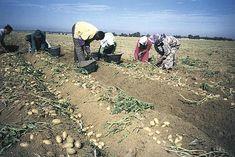
When it comes to early potatoes, even the product definition is clouded. For while a true early is still judged by the trade for its ability to have its skin removed with the thumb, size in this context is secondary. As a result several countries have also gained a reputation for providing what are loosely defined as “multi purpose” varieties that can also be used for chipping and mash.
Proof of the existing competition that is broadly spread over six months, between January and June, is reflected in import statistics covering some dozen or so established international supplier countries.
Imports contribute between 160,000 and 230,000 tonnes to the UK potato market each year, depending on market conditions. The supply calendar centres initially on the Mediterranean Basin, before moving to early production in Brittany and Jersey and then the first Pembroke, Cornish and Kentish potatoes follow in quick succession.
In an ideal situation, each source would neatly dovetail. But this seldom happens.
Early potatoes make a premium, hence the widespread use of polythene covers to move seasons forward in all sources. But initial yields are light and can be delayed particularly if there is a burst of cold weather or wet weather.
With the right conditions the crop can rapidly put on weight in days with the result that there can be a sudden surge in availability, which in turn can have an effect on the returns of other slightly later producers.
All new potatoes continue to compete for shelf space with the English stored maincrop.
As always, the weather also plays an important part in influencing the customers’ diet. An early warm spring increases demand, but a long, cold winter means heavy vegetables, chips and mash continue to dominate.
Meanwhile, sourcing for a market which has far less elastic consumption patterns than say fruit or salads, which are therefore more capable of riding times of glut and to a lesser extent shortage, has led to radical changes over the last decade.
Traditional sources such as Egypt - which has faced its own problems with brown rot - and Cyprus, where there is less land and water available due to tourism demands, have seen their exports shrink in size. Both export a winter and much larger spring crop, based on separate plantings. Cyprus is particularly valued by the chipping industry for its Cara and Diamante.
To illustrate the fall in prominence for both countries, in 1996, according to statistics provided by the British Potato Council imports of spring crop were some 64,000t and 45,000t respectively. But last year, which also represented an average season, these figures had shrunk to around 16,000t each. Overall market volume however has not lessened.
Competition has arrived from Israel, which in the last decade has seen exports boom from just 2,600t to more than 60,000t. Indeed this season the BPC weekly reports in June referred to a flooded EU market, pointing to record tonnages. The crop includes new and multi-purpose varieties including some that have been sold exclusively to individual multiples.
Italy, historically first on the winter market and associated with the Christmas new potato window, has faded to half its previous size, as a result of input by British growers, who have added a new dimension to the market with revolutionary production and storage techniques.
Throughout the year, imports are also coming under increased pressure from a rise in what are loosely called speciality potatoes. Identified for specific cooking purposes, these lines are garnering growing consumer loyalty and are becoming available year-round.
They first began to appear some 15 years ago with little-known UK novelties like Pink Fir Apple, and Ratte imported from France. But the range has subsequently expanded to include a wide portfolio, including waxy Charlotte, Carlingford, Nicola and red-skinned Roseval.
Their arrival on retail shelves has not diminished the reputation of the Jersey Royal, which is still regarded as the premium variety by most supermarket and wholesale buyers. Export volumes continue to range between 40,000-50,000t, limited by land availability, although, according to trade sources it has put a pressure on price with the result that there are fewer Jersey growers in existence.
And within this complex supply structure how have English growers fared?
Total planting has remained fairly constant at around 150,000 hectares, which of course takes no account of yields that are generally still increasing as more and more varieties are being grown on the most suitable land following the change in quota arrangements.
However if maincrop is static at around 95,000ha, a substantial switch has been evident elsewhere.
First early production in a recent five-year period has dropped from 14,500ha to 8,500ha in 2001. Premiere has trebled in 10 years and taken over the top spot from Maris Bard. Rocket volumes have shrunk and Ostera has all but disappeared in the same period.
By comparison, second earlies have, in effect, taken up the slack rising from 40,000ha to 47,000ha. Estima still holds pride of place but Nadine and Maris Peer is well up. Marfona remains similar but there are some newcomers such as Charlotte, Fambo and Saxon, which have replaced Ostera and reduced others.
Maris Piper continues to dominate main crop planting, representing about a third of the area of around 147,000ha, followed by Cara, Pentland Dell, Saturna, Desiree, Hermes and Rosetta of around 5,000ha each. Planted area of King Edward, probably still our best-known potato, has risen by some 1,000ha in the last five years to around 2,500ha.
And not to be forgotten, there has also been the reintroduction of several long lost maincrop albeit in tiny quantities, such as Highland Burgundy, Salad Blue and Arran Victory.
As ever, potato growing and marketing is not as simple as it seems.



